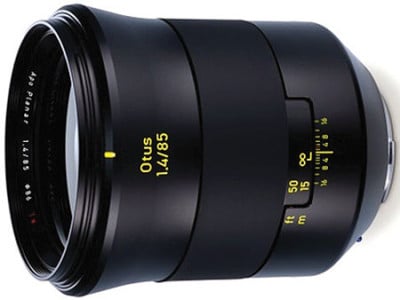Zeiss Otus 85mm f1.4 review
-
-
Written by Thomas
Quality
Longitudinal Chromatic Aberration and focus shift
With lenses offering an aperture of f2.8 or larger I test for longitudinal CA (loCA, a.k.a. “axial color” or “bokeh CA”). The Zeiss shows some magenta coloration in the foreground (left) and greenish hues in the background (right). This also shows up in real-life shots but is well controlled and much less pronounced than from the Nikon 85/1.4G. Rendering of white out-of-focus targets that are well behind the plane of sharpest focus does not exhibit the nasty green halos that some large-aperture primes produce – see my shot of the white cyclamen in my sample-images section.
Stopping the lens down does not produce a noticeable focus-shift.
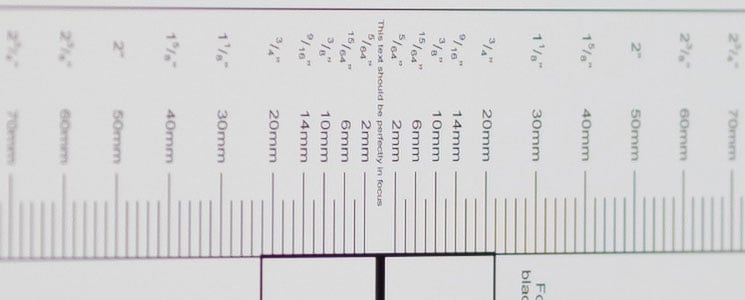
Above: Zeiss Otus 85/1.4 Longitudinal Chromatic Aberration (loCA) at f1.4. 100% crop, left = foreground, right = background
Sharpness and contrast
Let’s have a look at the theoretical performance (MTF-charts) compared to the Nikkor 85/1.4G first:
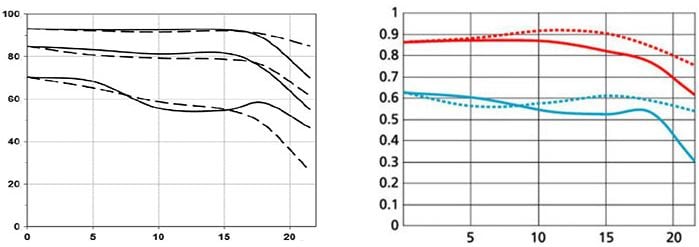
Above left: Zeiss Otus 85/1.4 MTF at f1.4, right: Nikon 85/1.4G MTF at f1.4
These charts show the lens-performance at the largest aperture f1.4. Higher values are better and the closer the dotted and the continuous lines of each pair of lines are together the less astigmatism (= resolution depends on the orientation of the test-pattern) the lens has. The x-axis displays the distance from the optical axis (=center of the sensor) in mm. I’ll show you the real-life performance at 4 mm (center), 13 mm (APS-C-corner), and 20 mm (FF-corner) on a D800.
The MTF-chart of the Zeiss Otus displays the contrast-curve at 10, 20 and 40 lp/mm (from top to bottom), which is a bit unusual. Other manufacturers like Nikon on the right display the contrast-curves at 10 lp/mm (in red) and 30 lp/mm (in blue).
From the charts the new Zeiss should perform on a higher level than the new Nikon 85/1.4G regarding overall contrast (10 lp/mm curve) across the sensor. And the 40 lp/mm curve of the Zeiss (showing the contrast at very fine details) is similar to the 30 lp/mm curve from the Nikon. So there’s a slight advantage on paper of the Zeiss over the Nikon. But let’s see how this theoretical differences in performance translate into real life results in the sharpness test based on Siemens-stars – and how the performance increases when you stop this lens down.
What follows are near-center results (first column) followed by APS-C-corner results and FF-corner results on a Nikon D800. The D800 results from the APS-C-corner should be a very good approximation for performance on a 16MP APS-C sensor (like the Nikon D7000), because the pixel-pitch of both sensors are the same. But differences in the AA-filter and micro-lens-design of a D800 and a D7000 might yield different end-results.
Processing was done in Lightroom 5.6 from RAW at camera standard settings. Noise-reduction is set to 0, sharpening to 70/0.5/36/10, with no extra tone, color, or saturation-adjustment. White-balance was adjusted to a neutral white and I did some exposure compensation to make the brightness match. CA-removal is ON. The new Zeiss is one of the very few lenses that exhibit almost no field-curvature at the shooting-distance for this test. So the following crops from the center, APS-C-corner and FF-corner of each aperture were taken from the same image.
Zeiss Otus 85/1.4 on Nikon D810; 100% crop from center, APS-C/DX-corner, FF/FX-corner

Above: 85mm, f1.4

Above: 85mm, f2.0

Above: 85mm, f2.8

Above: 85mm, f4.0

Above: 85mm, f5.6

Above: 85mm, f8.0

Above: 85mm, f11
These 100% crops directly from a 36MP D800 sensor show the excellent performance of this lens. Even at f1.4 only the full-frame corner suffers from a little haloing. Diffraction is setting in at f11. So for your landscape shots f8 would be your best bet. Distortions are minimal. The focus for the FF/FX-corner had to be optimized a bit so there is some field-curvature of this lens in the outer area of the sensor but center crop and APS-C/DX-corner crop are from the same shot.
Following is a direct comparison to the Nikon AF-S 85mm f1.4 at f1.4:

Above: Zeiss Otus 85/1.4 at 85mm, f1.4

Above: Nikon 85/1.4 at 85mm, f1.4
As you can see, the Zeiss clearly beats the Nikon lens in this test at all positions of the sensor. You need to stop the Nikon down to f5.6 to catch up with the Zeiss in the FX-corner.
Performance at long distances
The Siemens-star test-targets are shot at a distance of 40x focal length (i.e. at 3.4m). But performance of lenses also depends on the shooting distance. Therefore I do another series of test-shots of a landscape dubbed the “Unremarkables” where you can measure distances in km, not meter. I use this scene to show you how the lenses perform when almost everything is at infinity. I set White Balance to a standard daylight value to make them comparable across lenses shot at the same day and also try to make exposure comparable. There’s no tinkering with vignette-control so you see it here as it is produced by the lens. Focus was manually acquired at the largest aperture in live-view and not changed for other apertures.
You can click on the image to access the large original. Please respect our copyright and only use those images for personal use.
The main image shows the complete scene at maximum aperture to give you an impression of the angle of view and to judge vignetting. This is followed by one row of 100% crops from f1.4 to f8 each from the middle, the APS-C-corner and the right FF-corner.
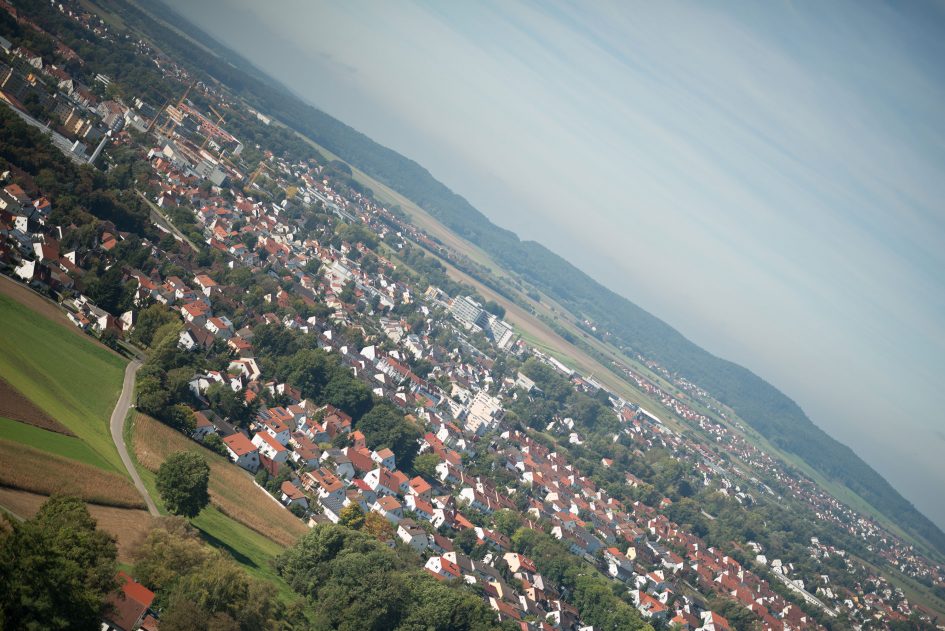
Above: Zeiss Otus 85/1.4 at f1.4; also available at f2.0, f2.8, f4.0, f5.6, f8.0
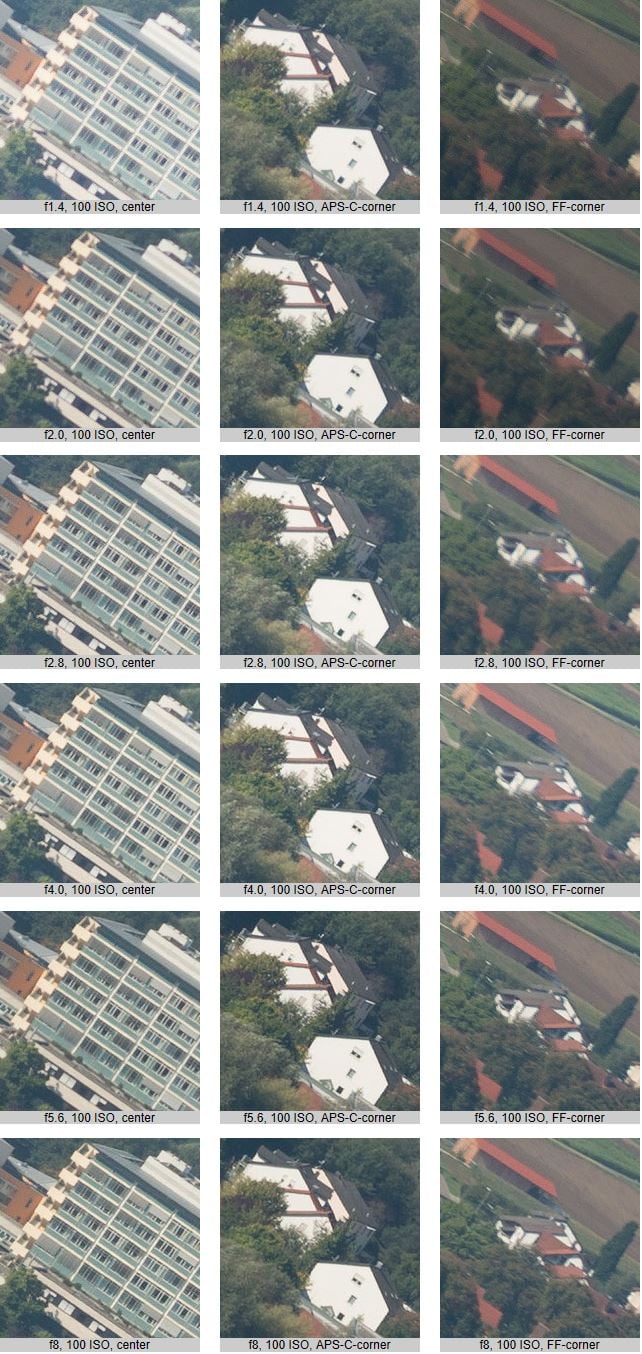
Performance is very impressive even wide open but the FF-corner shows some softening due to field curvature. Vignetting is clearly visible at f1.4 but is greatly reduced at f2.8. To get a really sharp FF-corner you need to stop down to f5.6.
I shot the same scene within minutes with Nikon 85/1.4G for comparison:
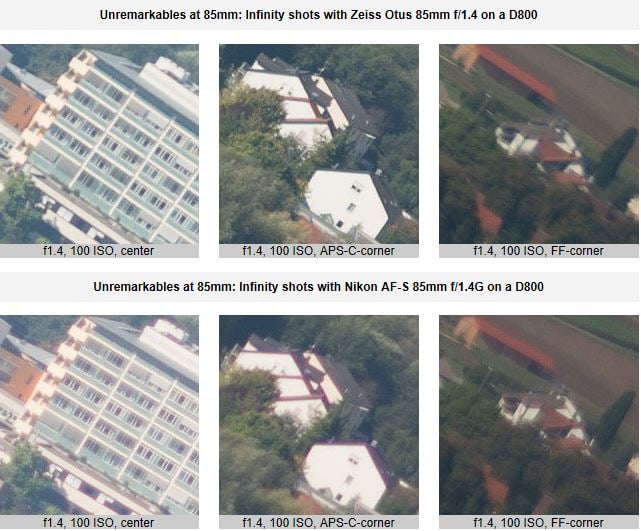
The shot of the Nikon 85/1.4G above is available at f1.4, f2.0, f2.8, f4.0, f5.6, f8.0.
Here the Nikon shows that beyond all the sometimes nasty longitudinal CAs it is a pretty sharp renderer that even looks a bit sharper in the FF-corner than the Zeiss Otus.
Rendering of point-light sources at night-shots
Night-shots pose a different challenge for lenses as the contrast is even higher than under bright sun and point-light sources can reveal some weaknesses such as coma, haloing and color-aberrations that do not show up as prominently in other test-shots. The following set of 100% crops from a night-shot show the results from the Otus in the first row compared to the Nikon 85/1.4G in the second row at f/1.4 shot only a few minutes apart:
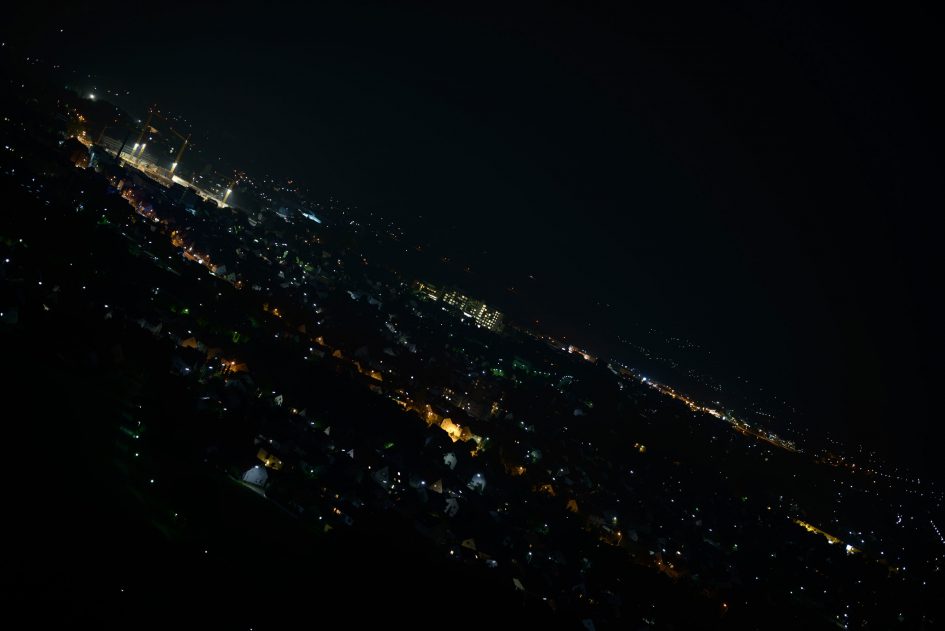
Above: Zeiss Otus 85/1.4 at f1.4; also available at f2.0, f2.8, f4.0, f5.6, and f8.0
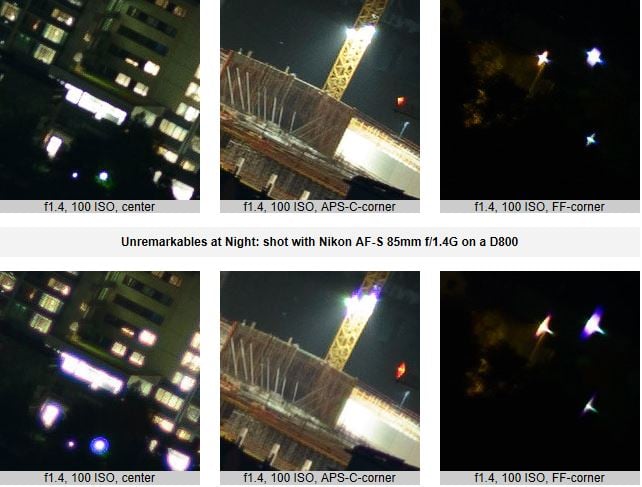
The shot of the Nikon above is available at 1.4, 2.0, f2.8, f4.0, f5.6, and f8.0.
The strong light-sources reveal that the Zeiss handles them better with less coloration, haloing, and coma (see crop from FF-corner) than the Nikon. The coma on the Zeiss is practically gone at f2.8 while you need to stop down the Nikkor to f4 to achieve the same effect.
All-in-all the Otus is an excellent performer near and far even on the very critical 36MP sensor of a Nikon D800. You can really use this lens wide open and get very good results. Just watch-out for the FF-corners in landscape shots or reproduction of flat subjects as you need to stop down to f4 or even f5.6 to beat the effect of field-curvature and/or coma. That’s a pity as the Zeiss Otus 55/1.4 handled this challenge flawlessly.
Rendering of out-of-focus point-light sources
This test is for the rendering of point-light sources in an out-of-focus background. The circle of confusion that is produced by this test is pretty indicative of Bokeh performance (in the background) and light fall-off. Ideally the out-of-focus image of the point-light is evenly lit and perfectly circular, with no “onion-rings”, and without coloration. Large aperture lenses normally produce an effect known as “cat’s eye” the further away from the optical axis the point-light is projected. This is due to optical vignetting in the lens barrel when light enters the lens from an angle. For an explanation of this effect have a look over at toothwalker.org. The following set of 50% crops from a night-shot show the results from the Otus in the first row compared to the Nikon 85/1.4G in the second row.
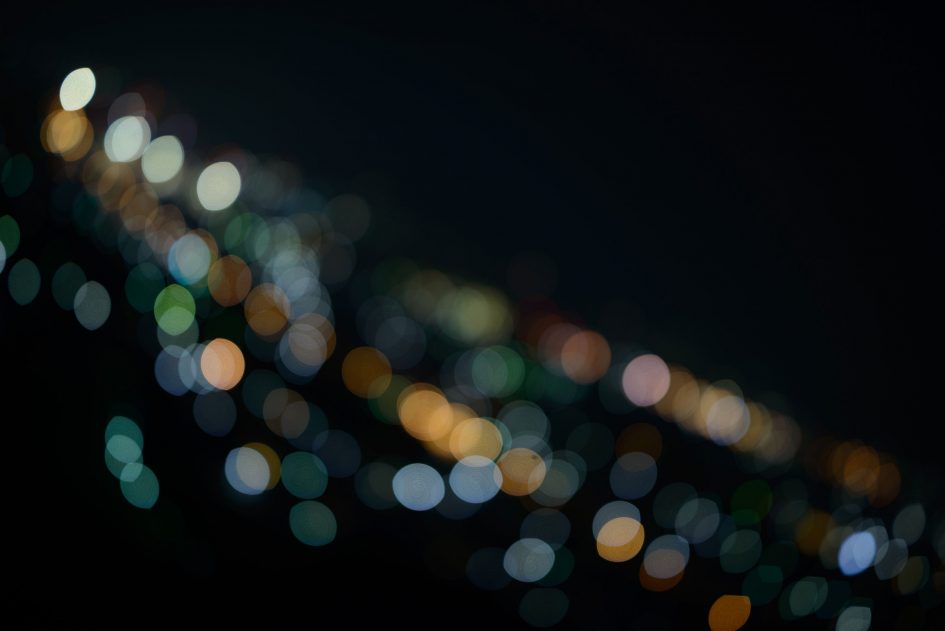
Above: Zeiss Otus 85/1.4 at f1.4; also available at f2.0, f2.8, f4.0, f5.6
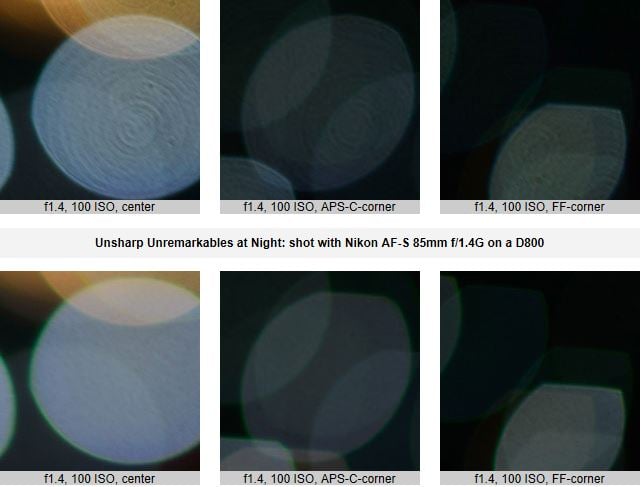
The shot of the Nikon above is available at 1.4, 2.0, f2.8, f4.0, f5.6.
The Zeiss 85/1.4 produces a large circle of confusion albeit a little smaller in the center than from the Nikon 85/1.4G. It exhibits a very even light-distribution across the circle but shows some onion-rings from the aspheric lens elements. The Nikon has no such elements and consequently shows no onion-rings at all. The Nikon has a very even light distribution too but shows some green outlining. Both lenses show some obvious cat’s-eye effect towards the borders/corners of the sensor. The clipping on the top of the cat’s-eye comes from the mirror-box of the D800 body and effects all circles at the top of the FX-sensor (showing up at the bottom of the image). You can see that the clipping is more prominent with the Nikon lens in the DX-corner. The clipping is gone by f2.8 (well, not quite with the Nikon) and the cat’s-eye effect is gone in the FX-corner by f4 on both lenses. For real-live Bokeh performance head over to the next page.
Flare/ghosting
Catching a strong light-source like the sun shining directly into the lens can not always be avoided. That could produce strange colorful ghosts-images or reduce contrast considerably through flare and glare.
The appearance of flare and ghosting depends on factors like the aperture and the angle of the light hitting the lens. So to judge the proclivity of a lens for these artifacts I went through a series of well calculated shots against a strong light source to provoke glare and ghosting.
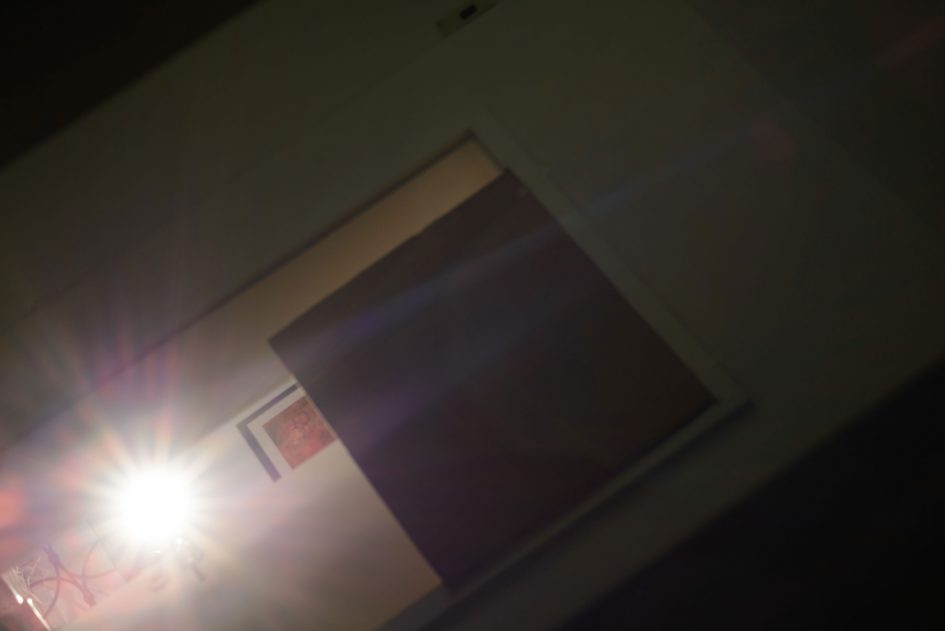
Above: Strong light hitting the Zeiss Otus 85/1.4 at f8.0
The image shows one of the worst flares from a series of 25 shots that I could produce with this lens – and that is pretty minimal considering the adverse conditions. There’s little veiling glare in images with strong contra-light and the blacks are mostly black. That is a very good performance comparable to the Nikon 85/1.4G with its Nano-coating.




